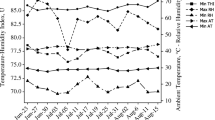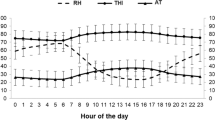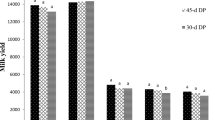Summary
Four lactating Friesian cows housed in climate chambers were exposed to the following sequential treatments: I, a four-week period when they were allowed constant access to anab lib supply of a complete diet and water in a thermoneutral environment (ambient temperature (Ta) 14 to 20°C and relative humidity (r.h.) 50 to 75%); II, a five-week period during which they were exposed to Ta 38·5°C/r.h. 85% for 6 1/2h during daytime and Ta 14 to 20°C/r.h. 50 to 75% for the remainder of each day with constant access toab lib complete diet and water; III, a four-week period under the same environment as treatment II but with access to food restricted to between 19.00 and 07.00; IV; a four-week period under the environmental and feeding regime described for treatment II. The voluntary food intake (VFI) of cows subjected to II was not depressed as a result of high daytime temperature despite the fact that they exhibited daytime clinical features indicative of heat stress; this was because of a 27·8% compensatory increase in night-time feeding. Nevertheless there was an accompanying significant increase in the rate of lactation decline of 8·7% per month greater than that normally expected under the thermoneutral conditions (I). Subsequent restriction of food access to night-time (III) resulted in a significant reduction in mean VFI of 7·5%; however, the rate of lactation decline was drastically reduced to a value not dissimilar to the natural decline of 3·97% per month observed under thermoneutral conditions (I).
Résumé
Quatre vaches frisonnes en lactation logées en chambre climatisée ont été soumises aux traitements successifs suivants: I-pendant une période de quatre semaines elles avaient accès constant à la fournituread libitum d'un régime alimentaire complet et d'eau dans un environnement thermique neutre (Température ambiante (Ta) 14–20°C et humidité relative (HR) 50–75 p. 100); II-pendant une période de cinq semaines elles étaient soumises à une Ta de 38°C/RH 85 p.100 pendant six heures et demi durant la journée et à Ta 14–20°C RH 50–75 p.100 pendant le reste de chaque journée avec accès constant à la fournituread libitum d'une alimentation complète et d'eau; III-pendant une période de quatre semaines les vaches étaient soumises au même traitement qu'en II mais avec accès à la nourriture limité à un nombre d'heures entre 19 h et 7 h du matin; IV-pendant une période de quatre semaines les vaches étaient soumises au même environnement et au même régime alimentaire que ceux décrits en II. L'ingestion volontaire d'aliments (IVA) des vaches soumises au régime II n'a pas diminué du fait de la température élevé de jour en dépit du fait qu'elles montraient, pendant la journée des signes cliniques indiquant un stress thermique. Ceci était dû à l'augmentation compensatoire de 27,8 p.100 de l'alimentation nocturne. Cependant on a noté une augmentation significative concomitante du rythme de déclin de lactation de 8,7 p.100 par mois de plus que celui normalement attendu dans des conditions thermiques neutres (I). La restriction ultérieure d'accés à la nourriture aux heures nocturnes (III) s'est traduite par une réduction marquée de l'IVA moyen de 7,5 p.100; cependant le rythme de déclin de lactation était réduit radicalement à un pourcentage à peu près similaire au déclin naturel de 3,97 p. 100 par mois observé dans des conditions thermiques neutres (I).
Resumen
Cuatro vacas Friesian alojadas en cabinas climáticas, fueron expuestas a los siguientes tratamientos: I. acceso constante a una dieta completa y aguaad lib en un ambiente térmico neutro (temperatura ambiental (Ta) 14–20°C y humedad relativa (HR) 50–75%), durante cuatro semanas: II. acceso constante a una dieta completa y aguaad lib, durante cinco semanas, a Ta de 38·5°C y HR de 85%, por 6 1/2 horas durante el día, y Ta 14–20°C y HR 50–75% por el resto de cada día, con acceso constante a una dieta completa y aguaad lib; III. durante un período de cuatro semanas, bajo las mismas condiciones ambientales que en el tratamiento II, pero con acceso restringido entre las 19.00 y 07.00 horas; IV. durante un período de cuatro semanas, bajo las mismas condiciones ambientales y dietéticas que en el tratamiento II. El consumo voluntario de alimento (CVA) de las vacas en el tratamiento II, no se deprimio debido a la temperatura alta durante el día, a pesar de que los animales mostraron estrés clínico; esto se debio al incremento compensatorio de 27·8% de alimentación durante la noche. Sin embargo, ocurrio un incremento significativo en la rata de disminución de la lactancia de 8·7% por mes, superior a lo que normalmente se esperaba bajo condiciones térmicas neutras (I). La restricción subsecuente de alimento durante las horas de la noche (III) resultó en una reducción significativa en el promedio de CVA de 7·5%; sin embargo, la rata de la disminución de lactación fue reducida drásticamente a un valor no diferente a la disminución natural observada (3·97%) por mes, bajo condiciones térmicas neutras (I).
Similar content being viewed by others
References
Ansell, R. H. (1976).World Animal Review,20, 1–7.
Bianca, W. (1965).Journal of Dairy Research,32, 291–345.
Folman, Y., Berman, A., Herz, Z., Kaim, M., Rosenberg, M., Mamen, M. & Gordin, S. (1979).Journal of Dairy Research,46, 411–425.
Kamal, T. H. & Seif, S. M. (1969).Journal of Dairy Science,52, 1657–1663.
Kamal, T. H. & Johnson, H. D. (1971).Journal of Animal Science,32, 306–311.
McDowell, R. E., Hooven, N. W. & Camoens, J. K. (1976).Journal of Dairy Science,59, 965–973.
Milk Marketing Board (1968–69). Studies of the lactation curve. Report of the Breeding and Production. Organisation, MMB, Thames Ditton. pp. 105–116.
Richards, J. I. (1985).Tropical Animal Health and Production (in press).
Thompson, G. E. (1973).Journal of Dairy Research 40, 441–473.
Yeck, R. G. & Stewart, R. E. (1959).Transactions of the American Society of Agricultural Engineers,2, 71–77.
Author information
Authors and Affiliations
Rights and permissions
About this article
Cite this article
Richards, J.I. Milk production of friesian cows subjected to high daytime temperatures when allowed food eitherad lib or at night-time only. Trop Anim Health Prod 17, 141–152 (1985). https://doi.org/10.1007/BF02355873
Accepted:
Issue Date:
DOI: https://doi.org/10.1007/BF02355873




